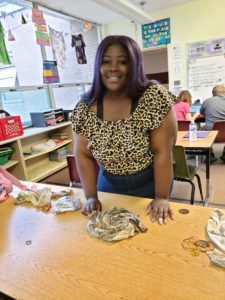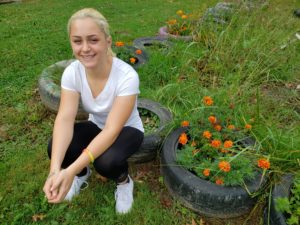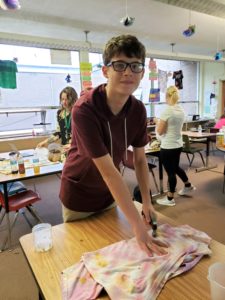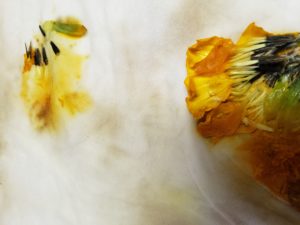 Walnut shells soaked in water, boiled, muddled and strained create a dye with a rich sepia hue. Marigolds, processed similarly, generate a pot of pink possibilities.
Walnut shells soaked in water, boiled, muddled and strained create a dye with a rich sepia hue. Marigolds, processed similarly, generate a pot of pink possibilities.
High school seniors studying environmental science at Summit Academy School for Alternative Learners-Warren Middle and Secondary are creating dyes from nature’s objects, many of which they planted in their school garden over the summer. They are also using the plantings as stencils and pressing some, such as flowers, into fabric.
“I like experimenting with different plants to make the dyes,” says senior Davon Morris as he stirs a bubbly mixture of boiling marigolds and water.

It’s a lesson where science meets art and then some. Think sustainability, natural resources, tie-dye and entrepreneurship.
“Our creative minds are put to use,” says Cheyanne Haun, reflecting on the lesson.
The students are using the natural dyes to create tie-dyed T-shirts.
Student Kara Faison bundles a shirt with rubber bands before she plunges it into a bath of reddish-brown dye. She and her classmates recently landed shelf space at Beautiful Whirl’d in Warren where their tie-dyed creations are up for sale. The students hope they raise enough funds to support a senior trip to Kalahari Waterpark in Sandusky.
Beautiful Whirl’d co-owner Mary Peronne says the shirts complement the store’s environmental-friendly emphasis as well as its overall culture and community commitment.
“We loved the fact that they’re tie-dyed. We’re known as being the hippies on the block,” Peronne says, adding that the students’ use of natural dyes make the shirts all the more appealing. “It fits in with our core values. We try to get on board as much as possible to support causes. We appreciate our community.”
 Student Anthony Pumphrey says the project is inspiring good business acumen.
Student Anthony Pumphrey says the project is inspiring good business acumen.
“It’s definitely teaching us entrepreneurship. You have to start out small and be humble about it,” says Pumphrey of the students’ growing collection of tie-dyed T-shirts and the sales he and his classmates hope they generate.
Aside from the retail opportunity, the science lesson – with its sustainability component – is enhancing the students’ learning experience and appreciation for natural resources, says teacher Sarah Thomas.
“Giving students the opportunity to explore uses for plants, especially ones that they have grown themselves, allows them to create connections with nature, which aids in creating a generation who understands the importance of nature and sustainable practices. Through this lesson, students are learning to forage in their own backyards for supplies that they can use in a multitude of ways. This helps students to not only identify plants in the field, but it also allows them to explore ways in which to utilize plants within their lives,” Thomas says.
Senior Jamie Santagata, who worked with her teacher over the summer tending to the school garden, says the class has had a positive influence on her, countering the negative ones often imposed by society.
“I think it’s cool we were able to make something beautiful … and green. It’s good for the environment.
 It encourages people to recycle,” Santagata says.
It encourages people to recycle,” Santagata says.
School Principal Erin Bradley says the lesson increases student engagement and gives pupils opportunities to see how science can be integrated across various academic disciplines.
“Ms. Thomas does a wonderful job with lessons that allow students to think outside of the box and be creative,” Bradley says.
